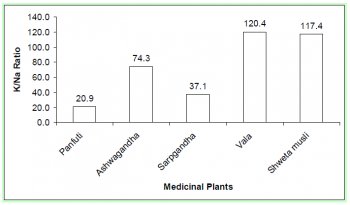
Indian Ayurvedic Plants

Keywords
Instrumental neutron activation analysis, atomic absorption spectroscopy, medicinal plants, trace elemental analysis, Inter-elemental correlationsIntroduction
There are many references to the curative properties of several herbs in the ancient Indian literature, Rigveda, though a more detailed account is found in the Atharvaveda from where Ayurveda, the Indian traditional health care system (ayus = life, veda = knowledge, meaning science of life) originated. Fairly comprehensive information about herbs has been recorded in two treatises Charak Samhita and Shusruta Samhita—a base for Ayurvedic system of medicine1, 2. These herbs are now being increasingly used in cosmetics, food as well as alternative medicine3. Some of the ingredients of allopathic and most of the Ayurvedic and Homeopathy medicines are derived from plants. Traditional Indian medical herbs used for strengthening the body immune system are known to have many essential and nutritional elements. Their excess or deficiency may disturb normal biochemical functions of the body4. Some western scholars have pursued the analysis of various Indian plants and herbs for their medicinal properties5. Most studies on such medicinal plants pertain to their organic contents, viz. essential oils, glycosides, vitamins, alkaloids and other active components and their pharmacological / therapeutic effects. Besides several organic compounds, it is now well established that many trace elements play a vital role in general well-being as well as in the cure of diseases6, 7. Several studies have reported elemental contents in plant extracts, which are consumed by us either as a herbal health drink or medicine 8-10. These elements are present at varying concentrations in different parts of the plants, especially in roots, seeds and leaves which are used as a dietary item as well as ingredient in the Ayurvedic medicinal preparation. The leaves of the plants are still used in some countries, as for instance, in Malaysia11, Greece12 and India13 particularly for their therapeutic effects. Since these trace elements constitute a minute fraction in different parts of the medicinal plants, a sensitive and reliable analytical technique is a prerequisite for obtaining precise and accurate data.
Considering the importance of trace elements in various human metabolic processes and also considering their curative properties, in the present investigation we have applied one of the sensitive analytical techniques like INAA to study the essential elemental content in different parts of Indian medicinal plants and herbs. The overall impact of these essential trace elements on human health is also discussed. Due to increasing industrialization and environmental pollution, the study was also extended to estimate the level of toxic elements present in these medicinal plant samples. Even though the direct link between the essential elemental content and their curative capacity is not yet established, the experimental data of the present work will be of immense importance in the synthesis of new Ayurvedic formulations. Also, it will help in deciding the proportion of various active constituents and managing dose of a particular formulation.
Since these trace elements constitute a minute fraction in different parts of the medicinal plants, a sensitive and reliable analytical technique is a prerequisite for obtaining precise and accurate data.
Considering the importance of trace elements in various human metabolic processes and also considering their curative properties, in the present investigation we have applied one of the sensitive analytical techniques like INAA to study the essential elemental content in different parts of Indian medicinal plants and herbs. The overall impact of these essential trace elements on human health is also discussed. Due to increasing industrialization and environmental pollution, the study was also extended to estimate the level of toxic elements present in these medicinal plant samples. Even though the direct link between the essential elemental content and their curative capacity is not yet established, the experimental data of the present work will be of immense importance in the synthesis of new Ayurvedic formulations. Also, it will help in deciding the proportion of various active constituents and managing dose of a particular formulation.Sampling
The various medicinal plants (Table 1) in the form of leaves and roots were collected from and around the Keshav Shrushti, Bhayander and Narsing K. Dube College, Nalasopara, Maharashtra, India. Surface contaminants of the plant samples were removed by washing with deionized water twice and then with deionized double distilled water. The leaves were air dried in a clean drying chamber and then dried at 80° C for overnight in an oven. The samples were powdered in agate mortar and passed through 100-mesh sieve. Sampling was done from this powder. Biological reference material namely CTA VTL-2 (IJCT Poland) was used as a reference multielemental standard. The concentrations of all the elements investigated in this study are well certified in the reference material.Irradiation and counting
About 50-80 mg of each sample was sealed in a polyethylene cover. Samples and reference standard were packed together and irradiated in the E8 position of the Apsara reactor, BARC. Irradiation time was varied between 30 min and 7 h depending on the half lives of the activation products. The sub-cadmium neutron flux in this position is in the order of 1x1012 cm-2 s-1. The samples were also irradiated at Dhruva reactor for 1 d in order to determine the elemental concentration of the long-lived radionuclides, such as Fe. The short irradiation and counting were conducted at the reactor site followed by spectra unfolding at the Radiochemistry Division of BARC, Mumbai. The radionuclides used for the analysis and their γ-energies are given in Table-2. All the samples and SRMs were counted at a calibrated sample-detector distance from a HPGe detector (Ortec) with 25% relative efficiency and 2.1 keV resolution at 1332.5 keV of 60Co line, which was connected, to an IBM PC XT computer system. A152 Eu γ-standard was used for efficiency calibration of the detector at different distances (8-15 cm) between sample and detector, in a stable source to detector geometry. Care has been taken to account for the counting losses by keeping the dead time around 5% at the start of the measurement. This has been maintained by choosing suitable duration of irradiation, 30 s to 1 minute in the case of pneumatic irradiation and keeping the sample to detector distance of 12-15 cm during...
Source: www.hsj.gr














